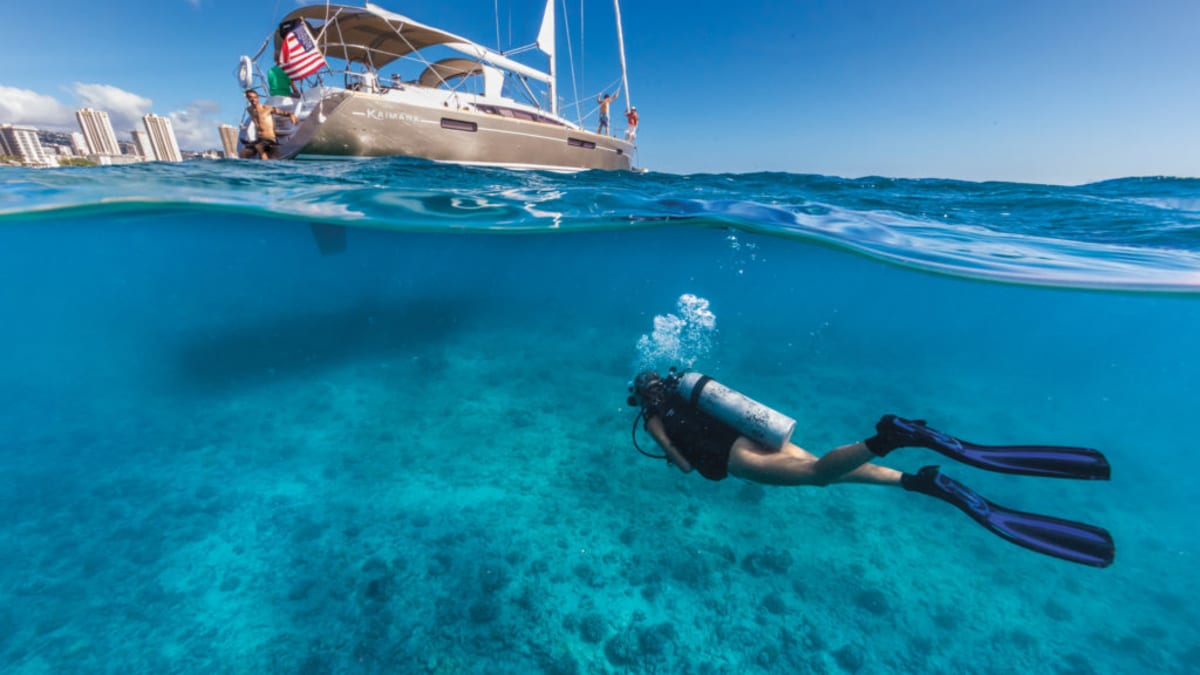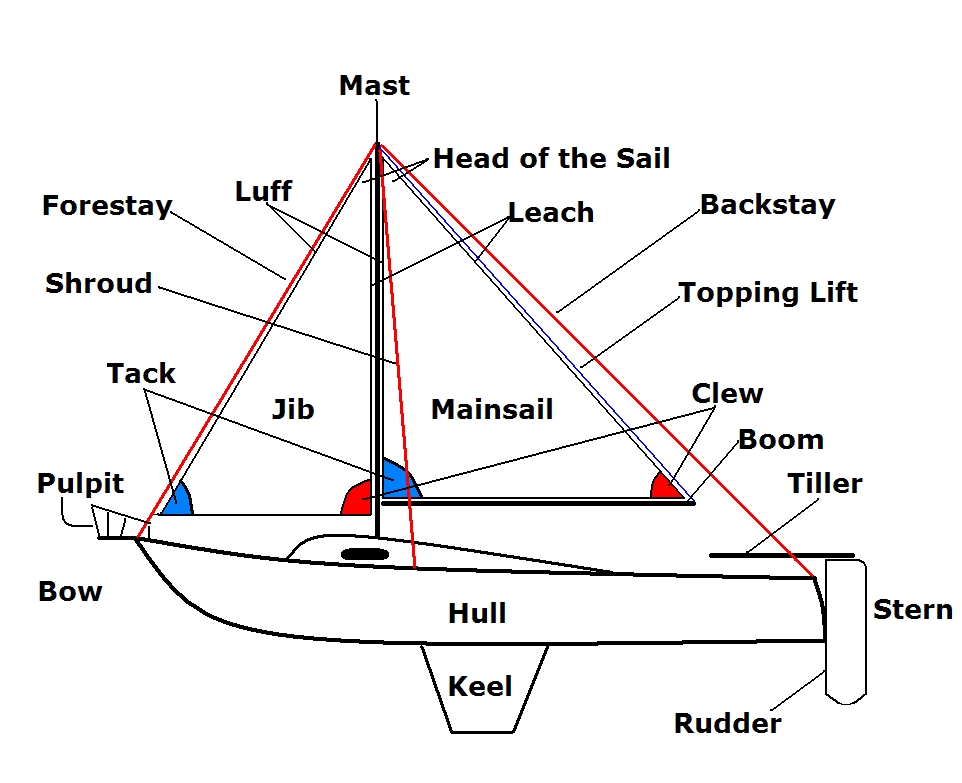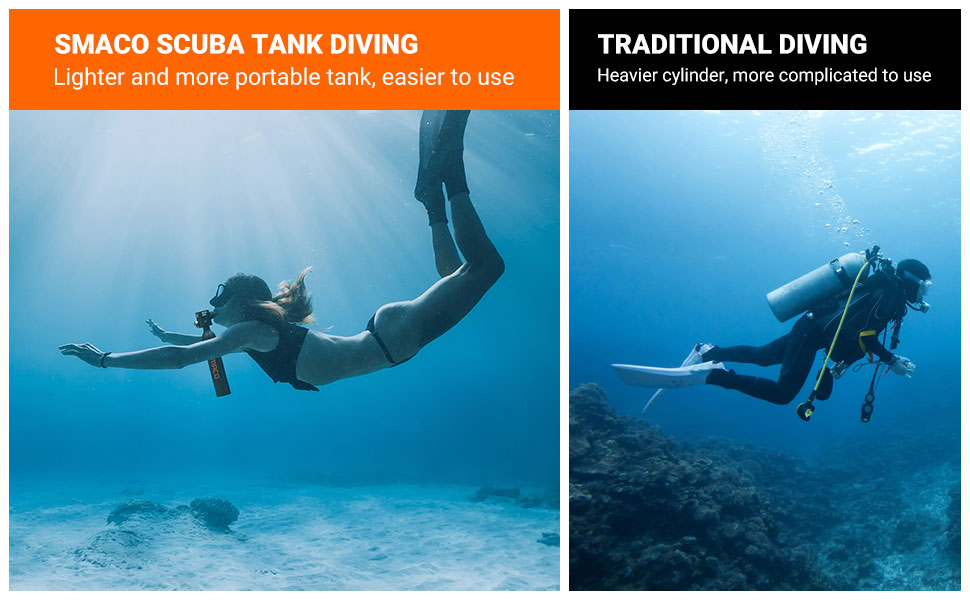Imagine the vast expanse of the ocean: above, the endless horizon where the sky kisses the sea; below, a hidden world teeming with life and mysteries. For centuries, sailors have been charmed by the surface of the sea, navigating its waves and exploring its coasts. But what lies beneath these waves is a realm just as fascinating and far more enigmatic. This is where the art of diving comes in, presenting a unique opportunity for sailors to enhance their maritime adventures.
For sailors, the ocean is not just a journey; it’s a passion, a lifestyle. Adding diving to their skill set opens up a new dimension to this lifestyle. It’s about more than just exploring the depths; it’s about understanding and interacting with the marine environment in a way that sailing alone can’t provide. This article aims to guide sailors who are intrigued by the idea of diving, showing how it can not only enrich their sailing experience but also provide practical benefits.
Diving offers a unique combination of adventure, tranquility, and intimacy with nature. It’s a chance to witness the unspoiled beauty of coral reefs, to swim alongside schools of vibrant fish, and to explore sunken wrecks that tell stories of the past. But beyond the sheer excitement and beauty, diving equips sailors with essential skills for underwater maintenance and emergency situations, enhancing safety and self-reliance at sea.
In the following sections, we’ll delve into the multifaceted benefits of diving for sailors, discuss the challenges and safety aspects, and explore the various levels of Professional Association of Diving Instructors (PADI) certifications, with a particular focus on the PADI Open Water Diver certification. Whether you’re looking to enhance your sailing adventures with new experiences or seeking practical skills for your seafaring life, diving offers a world of opportunities just beneath the waves.
So, let’s dive in and discover how this incredible skill can transform your sailing journey, bring you closer to the mysteries of the deep, and offer unforgettable experiences that resonate with the very essence of maritime exploration.
The Benefits of Diving for Sailors
Exploring Beyond the Deck
The first and most obvious benefit of diving for sailors is the expansion of their exploration capabilities. Diving allows sailors to experience the ocean in a three-dimensional space, going beyond the horizontal journey across the sea surface. This new vertical dimension opens up a world of underwater landscapes, marine wildlife, and historical wrecks, making every anchorage a potential adventure.
Practical Applications: Maintenance and Emergency Skills
Sailing is not without its challenges, and many of these occur below the waterline. Diving skills can be invaluable in various practical scenarios:
- Hull Inspections and Cleaning: Regular hull inspections are crucial for maintaining a vessel’s performance and safety. Diving allows sailors to perform these checks without needing outside help.
- Underwater Repairs: While major repairs will require professional services, divers can perform minor repairs or adjustments themselves, saving time and money.
- Emergency Situations: In case of entanglement in nets or ropes, a sailor with diving skills can resolve the issue swiftly, preventing potential damage.
Fishing and Spearfishing
For sailors living on their boats or undertaking long voyages, the ability to catch fresh seafood is a valuable skill. Diving enhances this ability, allowing sailors to engage in spearfishing or to collect shellfish and other sea delicacies.
Overcoming Challenges and Enhancing Safety
Dealing with Underwater Emergencies
Diving is not without its risks, especially in the unpredictable marine environment. Understanding how to manage these risks is crucial. This includes learning how to deal with potential underwater emergencies, such as equipment failure or encountering hazardous marine life.
Safety Precautions
Safety is paramount in diving. Sailors should always dive with a buddy, understand and respect their limits, and be familiar with emergency procedures. It’s also crucial to keep diving equipment well-maintained and to be aware of the weather and sea conditions.
Section 3: The Thrills of Diving
Personal Stories and Experiences
There’s nothing quite like sharing stories of diving adventures. From the exhilaration of swimming through a school of fish to the awe of encountering a majestic sea turtle, these experiences create lifelong memories and stories that can be shared with fellow sailors and loved ones.
Photography and Videography
Diving also opens up the opportunity for underwater photography and videography, allowing sailors to capture and share the beauty of the underwater world. This not only creates personal mementos but can also raise awareness about the importance of marine conservation.
This introduction to the benefits and thrills of diving for sailors sets the stage for the more technical aspects of diving certifications and training, which will be covered in the subsequent sections of the article. Through this exploration, sailors can see how diving is not just an exciting addition to their seafaring adventures but also a practical skill set that enhances their self-sufficiency and safety at sea.
Understanding PADI Certifications
Diving into the Depths: A Guide to PADI Levels
The Professional Association of Diving Instructors (PADI) offers a tiered system of certifications, each designed to build upon the skills and experiences gained in the previous level. Understanding these levels is crucial for sailors looking to dive safely and proficiently.
- PADI Open Water Diver: This is the entry-level certification. It equips you with the fundamental skills and knowledge needed for independent diving up to 18 meters deep.
- PADI Advanced Open Water Diver: After mastering the basics, this course helps divers improve their skills and start exploring specialized activities like deep diving or underwater navigation.
- PADI Rescue Diver: This level focuses on problem prevention and management, teaching divers how to handle dive emergencies and assist others if needed.
- PADI Master Scuba Diver: This is the highest recreational diver rating in PADI’s system. It requires significant experience and skill, representing a comprehensive understanding of various diving techniques and environments.
- PADI Divemaster and Instructor Levels: These professional certifications are for those who wish to guide or teach diving.
Each of these levels requires a combination of theoretical learning, confined water dives (usually in a pool), and open water dives to ensure that the diver is comfortable and competent in real-world diving situations.
The PADI Open Water Diver Certification
Embarking on the Diving Journey: Course Details and Skills
The PADI Open Water Diver course is where most sailors start their diving journey. It typically includes:
- Theoretical Learning: This covers basic principles of scuba diving, understanding of the equipment, and planning dives.
- Confined Water Dives: These are practice sessions in a pool or calm, shallow water, where you’ll learn basic scuba skills.
- Open Water Dives: Here, you apply what you’ve learned in the open water, under the supervision of a PADI instructor.
Skills acquired include:
- Basic Scuba Techniques: Breathing underwater, buoyancy control, and basic navigation.
- Safety Procedures: How to manage air supply, ascend and descend safely, and deal with potential hazards.
- Emergency Response Skills: Basic procedures for dealing with emergencies, including how to help a fellow diver in distress.
Advancing Your Skills
Beyond the Basics: Continuing Education in Diving
After obtaining the Open Water Diver certification, sailors can enhance their skills and experience through further courses:
- Advanced Open Water Diver: This course allows divers to explore specific interests like deep diving, night diving, or underwater photography.
- Specialty Courses: PADI offers a range of specialty courses, from wreck diving to fish identification, which can enrich your diving experience and knowledge.
The journey through PADI’s certification levels is both challenging and rewarding, offering sailors a structured path to becoming proficient divers. With each new level, sailors not only gain greater skills and confidence but also deepen their connection with the underwater world. This journey complements their sailing adventures, making them safer, more versatile, and more in tune with the marine environment.
Practical Tips for Combining Sailing and Diving
Seamlessly Integrating Diving into Your Sailing Life
Combining sailing with diving requires thoughtful planning and consideration, especially when it comes to equipment and choosing dive sites.
- Equipment Considerations: Space on a sailboat is limited, so it’s important to select diving gear that is compact and efficient. Consider lightweight, durable gear that can withstand the marine environment. Also, think about storage solutions that protect your equipment from saltwater and sun exposure.
- Choosing Dive Sites: While sailing, you’ll come across various potential dive sites. It’s crucial to assess these sites for safety. Factors to consider include current strength, visibility, depth, and potential hazards like boat traffic or dangerous marine life.
Maintaining Diving Gear on a Boat
Diving equipment requires regular maintenance to ensure its longevity and reliability. Rinse all gear with fresh water after each dive, check for signs of wear and tear, and service your equipment regularly. Also, be mindful of the need to fill your tanks and the availability of refilling facilities along your sailing route.
Environmental Responsibility
Diving with a Conscience: Marine Conservation
As sailors and divers, we have a responsibility to protect the marine environments we enjoy. This section would emphasize the importance of conservation-minded diving practices.
- Respect Marine Life: Avoid touching or disturbing marine life and corals. Understand that you are a visitor in their habitat.
- Responsible Interaction: Be cautious with activities like spearfishing. Follow local regulations and practice sustainable fishing methods.
- Conservation Efforts: Participate in or support local conservation initiatives. This can include beach cleanups, reef monitoring, or educational programs.
Conclusion
The Ultimate Sailing and Diving Adventure
Combining sailing with diving offers a unique and enriching experience that connects sailors more deeply with the ocean. It’s not just about the thrill of exploration or the practical benefits; it’s about forming a closer bond with the marine world and understanding its intricacies and beauty. Whether you’re diving into a vibrant coral reef, exploring a sunken wreck, or simply enjoying the serenity of the underwater world, diving adds an incomparable dimension to the sailing lifestyle.
We encourage sailors to consider diving as a natural extension of their seafaring adventures. By obtaining the appropriate certifications, respecting the marine environment, and integrating diving into their sailing journeys, sailors can unlock new horizons and experiences that the sea has to offer.
Additional Resources
To conclude, the article would provide a list of resources for sailors interested in diving. This could include recommendations for PADI-certified diving schools, popular diving locations around the world that are sailor-friendly, and forums or communities where sailors can share experiences and advice about combining sailing with diving.
Through this comprehensive guide, sailors can see how diving complements and enhances their relationship with the sea. It’s not just a sport or a hobby; it’s a way of embracing the full spectrum of what it means to be at one with the ocean.
Imagine the vast expanse of the ocean: above, the endless horizon where the sky kisses the sea; below, a hidden world teeming with life and mysteries. For centuries, sailors have been charmed by the surface of the sea, navigating its waves and exploring its coasts. But what lies beneath these waves is a realm just as fascinating and far more enigmatic. This is where the art of diving comes in, presenting a unique opportunity for sailors to enhance their maritime adventures.
For sailors, the ocean is not just a journey; it’s a passion, a lifestyle. Adding diving to their skill set opens up a new dimension to this lifestyle. It’s about more than just exploring the depths; it’s about understanding and interacting with the marine environment in a way that sailing alone can’t provide. This article aims to guide sailors who are intrigued by the idea of diving, showing how it can not only enrich their sailing experience but also provide practical benefits.
Diving offers a unique combination of adventure, tranquility, and intimacy with nature. It’s a chance to witness the unspoiled beauty of coral reefs, to swim alongside schools of vibrant fish, and to explore sunken wrecks that tell stories of the past. But beyond the sheer excitement and beauty, diving equips sailors with essential skills for underwater maintenance and emergency situations, enhancing safety and self-reliance at sea.
In the following sections, we’ll delve into the multifaceted benefits of diving for sailors, discuss the challenges and safety aspects, and explore the various levels of Professional Association of Diving Instructors (PADI) certifications, with a particular focus on the PADI Open Water Diver certification. Whether you’re looking to enhance your sailing adventures with new experiences or seeking practical skills for your seafaring life, diving offers a world of opportunities just beneath the waves.
So, let’s dive in and discover how this incredible skill can transform your sailing journey, bring you closer to the mysteries of the deep, and offer unforgettable experiences that resonate with the very essence of maritime exploration.
The Benefits of Diving for Sailors
Exploring Beyond the Deck
The first and most obvious benefit of diving for sailors is the expansion of their exploration capabilities. Diving allows sailors to experience the ocean in a three-dimensional space, going beyond the horizontal journey across the sea surface. This new vertical dimension opens up a world of underwater landscapes, marine wildlife, and historical wrecks, making every anchorage a potential adventure.
Practical Applications: Maintenance and Emergency Skills
Sailing is not without its challenges, and many of these occur below the waterline. Diving skills can be invaluable in various practical scenarios:
- Hull Inspections and Cleaning: Regular hull inspections are crucial for maintaining a vessel’s performance and safety. Diving allows sailors to perform these checks without needing outside help.
- Underwater Repairs: While major repairs will require professional services, divers can perform minor repairs or adjustments themselves, saving time and money.
- Emergency Situations: In case of entanglement in nets or ropes, a sailor with diving skills can resolve the issue swiftly, preventing potential damage.
Fishing and Spearfishing
For sailors living on their boats or undertaking long voyages, the ability to catch fresh seafood is a valuable skill. Diving enhances this ability, allowing sailors to engage in spearfishing or to collect shellfish and other sea delicacies.
Overcoming Challenges and Enhancing Safety
Dealing with Underwater Emergencies
Diving is not without its risks, especially in the unpredictable marine environment. Understanding how to manage these risks is crucial. This includes learning how to deal with potential underwater emergencies, such as equipment failure or encountering hazardous marine life.
Safety Precautions
Safety is paramount in diving. Sailors should always dive with a buddy, understand and respect their limits, and be familiar with emergency procedures. It’s also crucial to keep diving equipment well-maintained and to be aware of the weather and sea conditions.
Section 3: The Thrills of Diving
Personal Stories and Experiences
There’s nothing quite like sharing stories of diving adventures. From the exhilaration of swimming through a school of fish to the awe of encountering a majestic sea turtle, these experiences create lifelong memories and stories that can be shared with fellow sailors and loved ones.
Photography and Videography
Diving also opens up the opportunity for underwater photography and videography, allowing sailors to capture and share the beauty of the underwater world. This not only creates personal mementos but can also raise awareness about the importance of marine conservation.
This introduction to the benefits and thrills of diving for sailors sets the stage for the more technical aspects of diving certifications and training, which will be covered in the subsequent sections of the article. Through this exploration, sailors can see how diving is not just an exciting addition to their seafaring adventures but also a practical skill set that enhances their self-sufficiency and safety at sea.
Understanding PADI Certifications
Diving into the Depths: A Guide to PADI Levels
The Professional Association of Diving Instructors (PADI) offers a tiered system of certifications, each designed to build upon the skills and experiences gained in the previous level. Understanding these levels is crucial for sailors looking to dive safely and proficiently.
- PADI Open Water Diver: This is the entry-level certification. It equips you with the fundamental skills and knowledge needed for independent diving up to 18 meters deep.
- PADI Advanced Open Water Diver: After mastering the basics, this course helps divers improve their skills and start exploring specialized activities like deep diving or underwater navigation.
- PADI Rescue Diver: This level focuses on problem prevention and management, teaching divers how to handle dive emergencies and assist others if needed.
- PADI Master Scuba Diver: This is the highest recreational diver rating in PADI’s system. It requires significant experience and skill, representing a comprehensive understanding of various diving techniques and environments.
- PADI Divemaster and Instructor Levels: These professional certifications are for those who wish to guide or teach diving.
Each of these levels requires a combination of theoretical learning, confined water dives (usually in a pool), and open water dives to ensure that the diver is comfortable and competent in real-world diving situations.
The PADI Open Water Diver Certification
Embarking on the Diving Journey: Course Details and Skills
The PADI Open Water Diver course is where most sailors start their diving journey. It typically includes:
- Theoretical Learning: This covers basic principles of scuba diving, understanding of the equipment, and planning dives.
- Confined Water Dives: These are practice sessions in a pool or calm, shallow water, where you’ll learn basic scuba skills.
- Open Water Dives: Here, you apply what you’ve learned in the open water, under the supervision of a PADI instructor.
Skills acquired include:
- Basic Scuba Techniques: Breathing underwater, buoyancy control, and basic navigation.
- Safety Procedures: How to manage air supply, ascend and descend safely, and deal with potential hazards.
- Emergency Response Skills: Basic procedures for dealing with emergencies, including how to help a fellow diver in distress.
Advancing Your Skills
Beyond the Basics: Continuing Education in Diving
After obtaining the Open Water Diver certification, sailors can enhance their skills and experience through further courses:
- Advanced Open Water Diver: This course allows divers to explore specific interests like deep diving, night diving, or underwater photography.
- Specialty Courses: PADI offers a range of specialty courses, from wreck diving to fish identification, which can enrich your diving experience and knowledge.
The journey through PADI’s certification levels is both challenging and rewarding, offering sailors a structured path to becoming proficient divers. With each new level, sailors not only gain greater skills and confidence but also deepen their connection with the underwater world. This journey complements their sailing adventures, making them safer, more versatile, and more in tune with the marine environment.
Practical Tips for Combining Sailing and Diving
Seamlessly Integrating Diving into Your Sailing Life
Combining sailing with diving requires thoughtful planning and consideration, especially when it comes to equipment and choosing dive sites.
- Equipment Considerations: Space on a sailboat is limited, so it’s important to select diving gear that is compact and efficient. Consider lightweight, durable gear that can withstand the marine environment. Also, think about storage solutions that protect your equipment from saltwater and sun exposure.
- Choosing Dive Sites: While sailing, you’ll come across various potential dive sites. It’s crucial to assess these sites for safety. Factors to consider include current strength, visibility, depth, and potential hazards like boat traffic or dangerous marine life.
Maintaining Diving Gear on a Boat
Diving equipment requires regular maintenance to ensure its longevity and reliability. Rinse all gear with fresh water after each dive, check for signs of wear and tear, and service your equipment regularly. Also, be mindful of the need to fill your tanks and the availability of refilling facilities along your sailing route.
Environmental Responsibility
Diving with a Conscience: Marine Conservation
As sailors and divers, we have a responsibility to protect the marine environments we enjoy. This section would emphasize the importance of conservation-minded diving practices.
- Respect Marine Life: Avoid touching or disturbing marine life and corals. Understand that you are a visitor in their habitat.
- Responsible Interaction: Be cautious with activities like spearfishing. Follow local regulations and practice sustainable fishing methods.
- Conservation Efforts: Participate in or support local conservation initiatives. This can include beach cleanups, reef monitoring, or educational programs.
Conclusion
The Ultimate Sailing and Diving Adventure
Combining sailing with diving offers a unique and enriching experience that connects sailors more deeply with the ocean. It’s not just about the thrill of exploration or the practical benefits; it’s about forming a closer bond with the marine world and understanding its intricacies and beauty. Whether you’re diving into a vibrant coral reef, exploring a sunken wreck, or simply enjoying the serenity of the underwater world, diving adds an incomparable dimension to the sailing lifestyle.
We encourage sailors to consider diving as a natural extension of their seafaring adventures. By obtaining the appropriate certifications, respecting the marine environment, and integrating diving into their sailing journeys, sailors can unlock new horizons and experiences that the sea has to offer.
Additional Resources
To conclude, the article would provide a list of resources for sailors interested in diving. This could include recommendations for PADI-certified diving schools, popular diving locations around the world that are sailor-friendly, and forums or communities where sailors can share experiences and advice about combining sailing with diving.
Through this comprehensive guide, sailors can see how diving complements and enhances their relationship with the sea. It’s not just a sport or a hobby; it’s a way of embracing the full spectrum of what it means to be at one with the ocean.



